Pat Bertram's Blog, page 195
June 11, 2014
What Happens When You Find a Dead Body?
My dance class suggested I write a book about them. One woman even volunteered to be the victim, though I can’t imagine why anyone would want to kill her. She is lovely, charming, and utterly delightful. Yesterday we discussed what we would do after we found her body on the dance and before the cops showed up, and we decided we’d have dance class anyway. Why not? It was a mostly empty dance floor (except for the body, of course), we’d be dressed for the occasion, and our minds would not yet have processed the information that our classmate was truly gone. The will-be victim’s comment? “I am truly hurt that you would not mourn me.” In real life, of course, we’d mourn her, but a — hopefully — humorous book about aging women dancing despite the deaths they have had to deal with (not their own death, obviously) should be more about dancing than death.
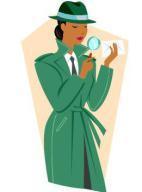 I can never start writing a novel until I have the beginning of the story, and the end, which I do have. I begin with our plans to write the book about the murder, then segue into the “real” murder. I end with our dancing the perpetrator to death. (Well, it is a dance class, after all. Dance should have a significant part in the story.) I even know who the perpetrator is, and I think I know why he killed Ms. Delightful. (He thought she was Ms. Teacher.)
I can never start writing a novel until I have the beginning of the story, and the end, which I do have. I begin with our plans to write the book about the murder, then segue into the “real” murder. I end with our dancing the perpetrator to death. (Well, it is a dance class, after all. Dance should have a significant part in the story.) I even know who the perpetrator is, and I think I know why he killed Ms. Delightful. (He thought she was Ms. Teacher.)
Most of all, I have everyone’s permission to use them in the story. A couple of the women were wary, some were looking forward to what I’d say about them, and most lit up with excitement at the thought of being in a book.
Now comes the hard part. (Well, the second hardest part. The hardest part will be actually sitting down and putting words on paper.) What happens after we discover the body? Who comes to the scene? What do they do with us? How/where do they take our statements if in fact they do take our statements? How/where do they take our fingerprints?
Most of what I know about crime scene handling comes from movies and TV shows, so most of what I know is probably wrong. And anyway, such information is from the point of the cops, and in the book, I won’t be a cop. I’m only one of a half-dozen women who discover the body. So where am I when the cops, the criminalists, the DA, and everyone else are there? Have they taken preliminary reports — perhaps names, addresses, relation to the deceased — and sent us home? If so, when do they take our statements? Do they call us to come in to the police station?
I found information about the review process here: Criminal Defense Witness Interviews & Statements, which answers many of my questions about the interview process but not actually the beginnings of the process.
Some of those questions are answered here: Investigating the Crime Scene. According to this article, the first cops on the scene are supposed to preserve the crime scene, isolate witnesses, take “names, addresses, dates of birth, and telephone numbers, etc.” (Etc? what the heck does that encompass? It’s those etcs I need to know.) According to this article, the patrol supervisor will interview witnesses. The detective will interview witnesses again and arrange transport for witnesses to be sent to headquarters and will take written statements. Another article about searching and examining a major crime scene contains no mention of anyone but various law enforcement folk.
So, are those who find the body considered witnesses? I guess. Oddly, there doesn’t seem to be much online about what happens to those who find a dead body, except for articles about how doing so can mess you up for life. But those people obviously weren’t taking dance classes. Dancing can unmess you up.
I’ve been trying to find out how those who find a body are dealt with by the police, but most answers to that question involve describing what the police do. In my proposed book, I’m not a cop. I’m me. What do I do? Or more to the point, what will they do to me? (I did come across this humorous (at least, I hope it’s supposed to be humorous and not someone’s experience of what actually happened) article about what to do if you find a dead body. Another article I came across is HowTo:Commit the Perfect Murder. Oh, my.
Nor can I find out how long before the crime scene will be released. We want to dance! How can we dance if the studio is barred from us? It also will need to be a quiet little murder, not much smell or gore, because . . . well, that would put a damper on dancing.
Hmm. Maybe I need to think about this a bit more.
***
Pat Bertram is the author of the suspense novels Light Bringer, More Deaths Than One, A Spark of Heavenly Fire, and Daughter Am I. Bertram is also the author of Grief: The Great Yearning, “an exquisite book, wrenching to read, and at the same time full of profound truths.” Connect with Pat on Google+. Like Pat on Facebook.
Tagged: crime scene investigation, handling a crime scene, police and witnesses, what happens after discovering a body, witnesses to finding a body, writing a mystery


June 10, 2014
Today’s Weather
Need I say more? Well, maybe I do. We’re also dealing with 25-mile-an-hour winds that do nothing to cool the scorch. Ouch.
I hope you’re having a cool, calm day.
***
Pat Bertram is the author of the suspense novels Light Bringer, More Deaths Than One, A Spark of Heavenly Fire, and Daughter Am I. Bertram is also the author of Grief: The Great Yearning, “an exquisite book, wrenching to read, and at the same time full of profound truths.” Connect with Pat on Google+. Like Pat on Facebook.
Tagged: scorch, today's weather


June 9, 2014
Load Bearing and the Human Body
I know nothing about the mechanics of load bearing or proper ergonomic balance. I don’t even know what ergonomics is. Never really cared. But such topics have been showing up in my research into the best way of carrying loads long distances using only the human body.
I’m considering taking an epic walk, perhaps up the Pacific coast, and I’ve been trying to think outside the envelope, box, and backpack. An envelope, of course, could not contain all I would need to carry; though I do intend to travel light, that is too  light even for me. A box would be too awkward. And a backpack — well, for those of us not used to carrying loads on our backs, a back pack can contribute to back and neck problems, gait issues, muscular pain, foot problems, bad posture, and wasted energy.
light even for me. A box would be too awkward. And a backpack — well, for those of us not used to carrying loads on our backs, a back pack can contribute to back and neck problems, gait issues, muscular pain, foot problems, bad posture, and wasted energy.
In my case, even light loads in a backpack are a problem. I recently lost a few pounds, so I figured my body would be able to handle a five-pound backpack load with no difficulty, but that wasn’t the case. After a mere three miles, I ended up with pain on the tops of my feet and in my lower back. Someone suggested that I get orthotics, but why would I need them when I’d been used to carrying more weight without even a hint of discomfort?
I have a short back, and according to Aarne Packs, “With a backpack, the center of gravity of the load is behind the body. The load acts like a lever on your back, increasing the forces acting on the body well above the force of the weight alone. When this lever acts over a shorter distance on a small torso, the forces are magnified. Therefore the reason women with short torsos may not be able to carry such heavy loads is not because they are weaker but because of these increased forces.”
When you carry extra body weight (as opposed to carrying some kind of pack), the weight is distributed all through the body, so no single muscle group or tissue has to deal with the load, which cuts down energy expenditure as well as muscle fatigue, and there is no change in the center of gravity. Ideally, then, an external load-bearing system would need to take those matters into consideration.
Traditionally, humans have used various means of transporting loads on their bodies: a simple hobo pack with a bandanna tied on the end of a stick, a pole balanced on the shoulders with a basket hanging from each end, a trumpline around the head tied to the load hanging down the back (supposedly this allows a person to carry greater loads longer distances than shoulder straps, but . . . ouch; my neck is squealing in pain just thinking about it), and the ever popular balancing the load on top of the head.
Balancing loads on the head, if done right, is supposed to be the best way since there is zero increase in metabolism. It has to do with one’s gait. According to Biomechanics of Locomotion, when we walk, our bodies go “up and down, and faster and slower, within each step. The energy changes associated with these fluctuations in height and speed are out of phase and therefore tend to cancel each other, minimizing the energy required to keep the movements going, much like in a pendulum. But in walking the energy fluctuations are not completely cancelled (as would occur in a perfect pendulum); at most about 65% of the energy fluctuations are cancelled, leaving at least 35% of the energy fluctuations which must be supported by the muscles each step, requiring metabolic energy input. When the African women carry loads on their heads, they are able to increase the amount of energy that is cancelled, reducing the muscular energy required to maintain the walking gait and compensating for any increase in muscular energy required to support the additional load.”
Carrying loads on one’s head might be fine for those who are used to it or even for those trying to improve their posture, but I cannot see me balancing anything on my head (except perhaps a hat) for hundreds, maybe thousands of miles.
I’ve been considering making two shoulder tote bags, one for each side, thinking that might help balance the weight in a more natural way, or perhaps a combination of a light backpack, belly bag, and maybe side bags. Apparently, these are good ideas. In fact, I don’t even have to make these load-bearing packs. Someone already did. One company I found makes a pack with the load balanced on either side of the body, and another company makes a pack with front pockets to balance the weight of the backpack, though the pack itself is much heavier than I would like.
It’s amazing to me all the things one has to consider when going for a simple (well, perhaps not so simple) walk, especially if one doesn’t want to look like the survivor of a wilderness romp.
***
Pat Bertram is the author of the suspense novels Light Bringer, More Deaths Than One, A Spark of Heavenly Fire, and Daughter Am I. Bertram is also the author of Grief: The Great Yearning, “an exquisite book, wrenching to read, and at the same time full of profound truths.” Connect with Pat on Google+. Like Pat on Facebook.
Tagged: alternatives to backpacks, backpacks, backpacks and short torsos, best way of carrying loads, carrying loads on head, gravity and backpacks


June 8, 2014
The World of Writing as I Know It
Debra Purdy Kong is an established mystery writer with two published series: The Casey Holland mysteries and the Alex Bellamy mysteries. She has her own blog, and she’s also a co-contributor on The Write Type blog, posting marvelous articles about the state of the publishing industry, such as How Social Media Helps, and Hurts, Are Conferences Losing Attendees? and Interesting Info on the State of Publishing.
When Debra asked me to take part in a blog tour that focuses on the writing process, I jumped at the chance if for no other reason than to introduce this fascinating woman. The arrangement is that I answer four questions about writing, then choose three other writers who will do the same. So I choose . . . you and you and you! All you have to do is answer the following questions on your blog and add a link back to me.
#1) What Am I Currently Working on?
Right now, I’m still concentrating on posting a blog a day, and I’m working on a non-writing project. That project should be finished in about three weeks, and then I will begin writing a new novel, something fun and whimsical. It started when my dance class suggested I write a book about them. One woman even volunteered to be the victim, though I can’t imagine why anyone would want to kill her. She is lovely, charming, and utterly delightful. I wasn’t going to write the story since it seemed a good way to lose a lot of friends, but at the lunch the other day, I almost whacked one of my classmates with my dance bag, and she deadpanned, “I’m not the one who volunteered to be the murder victim.” So I decided to write the book. I mean, how could I not use such a perfect line?
#2) How Does My Work Differ From Others of Its Genre?
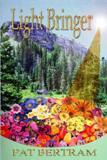 I don’t really write to a genre. Libraries and bookstores used to be set up with a mystery section, a romance section, a science fiction section, and then all the rest of the novels. That’s what mine are — one of “all the rest.” (When I’m forced to name a genre, I say suspense/mystery because my novels fit better in that category than any other.)
I don’t really write to a genre. Libraries and bookstores used to be set up with a mystery section, a romance section, a science fiction section, and then all the rest of the novels. That’s what mine are — one of “all the rest.” (When I’m forced to name a genre, I say suspense/mystery because my novels fit better in that category than any other.)
The disheartening aspects of not having a genre are more than offset by the joy of having created four unique visions of the world, dozens of characters who would not have life without me, and vivid word pictures that exist only in my books.
Each of my books shows a particular vision of the world as I know it. A Spark of Heavenly Fire shows the horror of an all-too-possible pandemic, the even more horrific steps the government is ready to take, and the various ways, both heroic and craven, people might react to such an eventuality. More Deaths Than One shows the unthinkable results of mind control experiments, experiments that have actually been perpetrated without our knowledge. Daughter Am I is a more light-hearted romp, a treasure-hunting tale of finding oneself in a most unlikely way. And Light Bringer hints at a world where the Sumerian myth of a tenth planet — a planet of doom — is fact.
#3) Why Do I Write What I Do?
I write what I do because those stories captured my attention and kept it during the long months it takes me to write a novel. I know I’d be better off if I tried to write books that would capture the attention of a large readership, but I can only write what I’m enthusiastic about.
#4) How Does My Writing Process Work?
Seems silly, I know, in this electronic age, but I write fiction in pencil on loose-leaf paper. (I have a better mind/writing connection using pencil and paper than I have with a keyboard; a mechanical pencil is easier on my fingers than pen, and paper is easier on my eyes than a computer screen.)
I don’t know the entire story before I writing, but I do know the beginning, the end, and some of the middle. That way I can have it both ways: planning the book and making room for surprises.
I need to know a bit about the hero, but most of the time I get to know the characters the same way a reader would — by the way the characters act. I also need to write the story in the order it happens — it’s more satisfying for my logical mind and easier to keep track of — but if I get to a place where I know something happens without knowing what, I will skip it and go back later when I know what is missing.
So, there you have it. That’s how I write.
What about you? What are you currently working on? How does your work differ from others of its genre? Why do you write what you do? How does your writing process work?
***
Pat Bertram is the author of the suspense novels Light Bringer, More Deaths Than One, A Spark of Heavenly Fire, and Daughter Am I. Bertram is also the author of Grief: The Great Yearning, “an exquisite book, wrenching to read, and at the same time full of profound truths.” Connect with Pat on Google+. Like Pat on Facebook.
Tagged: current projects, Debra Purdy Kong, how my genre is different, why I write what I do, writing longhand, writing process


June 7, 2014
On Writing: The Importance of Setting
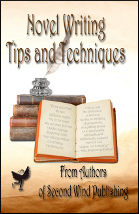 Deborah J Ledford, in “Captivating Settings,” a section from Novel Writing Tips and Techniques From Authors of Second Wind Publishing, stresses the importance of setting, of putting readers at ease and giving them a visual at the beginning of each chapter, especially the first time the location is presented. As the author of the popular Deputy Hawk/Inola Walela thriller series, Deborah J Ledford knows what she is talking about. We do need to be aware of our surroundings. In real life, if we were to awaken in an empty room — or heaven forbid, hanging in empty space — with no indication of where we are, even the most equanimous would be uncomfortable. The rest of us, of course, would be panicked out of our minds.
Deborah J Ledford, in “Captivating Settings,” a section from Novel Writing Tips and Techniques From Authors of Second Wind Publishing, stresses the importance of setting, of putting readers at ease and giving them a visual at the beginning of each chapter, especially the first time the location is presented. As the author of the popular Deputy Hawk/Inola Walela thriller series, Deborah J Ledford knows what she is talking about. We do need to be aware of our surroundings. In real life, if we were to awaken in an empty room — or heaven forbid, hanging in empty space — with no indication of where we are, even the most equanimous would be uncomfortable. The rest of us, of course, would be panicked out of our minds.
Although being unacquainted with where we are in a story wouldn’t panic us, it would prevent us from settling into the novel. We’d be searching the pages warily wondering where we are and even worse, wondering if we want to continue reading.
In the past couple of days I had the dubious honor of reading the first chapters of two new books on the market, and combined, they show the importance of setting a scene and doing it properly.
The first book had absolutely no setting. It was as if the characters were hanging in the air, held to the page only by the thin strings of their words. There was no “there” there, and I had no desire to keep reading. If the writer didn’t care enough about me as a reader to let me know where I was, I certainly didn’t care about the story.
The second book had too much setting, describing the initial scene at great length with lots of awkward constructions using “had”s and “you”s, and meanderings into the past, that I had no interest whatsoever in the story, even though I did know where I was. Instead of describing the setting using vague and anecdotal constructions, she could have used the setting in a more dynamic way, evoking mood, atmosphere, making the setting part of the action. Most importantly, she should have searched for a couple of telling details — the sights, sounds, smells, feel, tastes that evoke the entire feeling of the setting.
In  the 1980s, bookracks in grocery stores were full of gothic romances. Perhaps you remember seeing those covers: a brooding mansion in the background, a woman in a diaphanous gown running away from the house, looking back at it in fear. Despite their triteness, those were dynamic covers: the pictorial description of the house, the effect on the character (fear), and how the character reacted (running away.) Written description can be as vibrant as those covers; it just means taking the description a step further and filtering it through the senses of a character.
the 1980s, bookracks in grocery stores were full of gothic romances. Perhaps you remember seeing those covers: a brooding mansion in the background, a woman in a diaphanous gown running away from the house, looking back at it in fear. Despite their triteness, those were dynamic covers: the pictorial description of the house, the effect on the character (fear), and how the character reacted (running away.) Written description can be as vibrant as those covers; it just means taking the description a step further and filtering it through the senses of a character.
In this example from my novel More Deaths Than One, we already know that Bob and Kerry are in a hotel in Bangkok, but now we get an impression of the hotel room from Kerry’s reaction.
Bob opened his eyes, then squeezed them shut against the light. From the heaviness of the air and the brightness of the day, he presumed it was mid-morning. He opened his eyes again and this time managed to keep them open.
He turned his head toward Kerry. She lay on her back, hands behind her head, eyes focused on the ceiling. Following her gaze, he realized she was staring at one of the ubiquitous green lizards. Her body vibrated with excitement.
He smiled to himself. Leave it to Kerry to be thrilled with this small reminder they were no longer in Colorado.
“Isn’t this great?” she said in a hushed voice. “We have our own private watch lizard.”
Bob brushed away a fly buzzing around his head. “We could use a few more.”
Later, the description of the hotel becomes an integral part of the Bob’s worry.
The hotel was built around a courtyard accessible from all the rooms. Bob took his breakfast out to the courtyard, but couldn’t enjoy the fountain, the bushes, the flowers. He kept stealing glances at the windows, wondering if anyone was watching him.
When dark clouds rolled across the sky, pushing a stifling humidity before them, he took refuge in his room. It did not have air-conditioning, but the slowly revolving ceiling fan offered a modicum of relief.
He paced the floor, feeling as if he were a stranger in this land. It didn’t matter that he had lived here for sixteen years, he realized; any place would seem alien when he wasn’t with Kerry. She was his home.
He tried not to worry about her all alone on the streets, but as time passed, the worry grew too strong to ignore.
Then the rains fell. There was no light spattering gradually increasing in intensity as in Colorado, but an abrupt opening of the skies as if someone had turned on a spigot.
Because of the emotions evoked, the brief descriptions in no way stop the forward movement of the story.
Other posts you might be interested in:
Describing a Scene in an Interesting Way
Describing a Winter Scene
Describing a Winter Scene — Again
Describing a Winter Scene — Again. And Yet Again.
Describing the Nondescript
***
Pat Bertram is the author of the suspense novels Light Bringer, More Deaths Than One, A Spark of Heavenly Fire, and Daughter Am I. Bertram is also the author of Grief: The Great Yearning, “an exquisite book, wrenching to read, and at the same time full of profound truths.” Follow Pat on Google+. Like Pat on Facebook.
Tagged: Bangkok, Deborah J. Ledford, description, description and emotion, dynamic description, gothic romances


June 6, 2014
After Kicking the Bucket List
A few days ago I mentioned in a blog that I didn’t have a bucket list because there are too many things in the world that either I’m not aware of that perhaps I would like to do, or if I am aware of the things, I’m not aware that I would like to try them.
Several people pointed out that bucket lists have become a cliché, which they are, but the way I figure it, they are also redundant. A bucket list is a list of things you want to do before you die. As far as I know, every list is a list of things one wants to do before they die. A shopping list is more immediate and a heck of a lot less exciting than a list of activities such as sky diving or mountain climbing, but still, it’s a list of things to do while you are alive.
I have yet to see a list of things to do after one kicks the bucket, though I imagine such a list would read:
1) Make an appointment with God.
2) Tell Him/Her what He/She did wrong when creating the world.
3) Learn how to play the harp.
4) Shop for the latest fashion in wings and halos.
Or, in a more dire situation:
1) Amass a stock of aloe for burns.
2) Find your friends, especially those your parents once warned you about.
3) Look for a hot guy.
4) Have a hell of a good time.
Now those are bucket lists!
***
Pat Bertram is the author of the suspense novels Light Bringer, More Deaths Than One, A Spark of Heavenly Fire, and Daughter Am I. Bertram is also the author of Grief: The Great Yearning, “an exquisite book, wrenching to read, and at the same time full of profound truths.” Follow Pat on Google+. Like Pat on Facebook.
Tagged: after kicking the bucket list, bucket list, kicking the bucket, making lists


June 5, 2014
Requiem for Online Dating
Six months ago, a married friend urged me to join a dating site, more, I think, to fulfill her own fantasy of going out with a lot of different men than because of any perceived need of mine. She promised to help me weed through the site to find men who might be compatible, but still it took one entire sleepless night for me to make the decision to play her game. I’m not sure what I was afraid of — moving even further beyond my deceased life mate/soul mate perhaps. Or maybe accidentally falling in love again and tying my future to another person.
Although I wasn’t looking for a serious relationship, I was lonely. Thinking it would be fun to meet people, maybe go on a few dates, I signed up for a dating site and paid for a six-month subscription. I originally planned to pay for one month, but I didn’t want to sabotage myself by counting the cost.
At the beginning, I wrote charming messages to all the men my friend thought might be suitable, and even some the site found for me, though the site’s computers seemed to think I was looking for an inarticulate, overweight, tattooed smoker who rides a motorcycle. Um, no.
I suppose it’s understandable I got not a single response to my notes. Inadvertantly, I’d created a profile that guaranteed I wouldn’t catch any man’s attention — I told the truth about myself, used more than 95 words, didn’t downplay my intelligence, didn’t show cleavage, didn’t use words like “fun-loving” that could connote an eagerness f or mattress games, and most of all, I didn’t lop years off my age. Eek. I must have seemed like their worst nightmare!
or mattress games, and most of all, I didn’t lop years off my age. Eek. I must have seemed like their worst nightmare!
I eventually joined two free sites besides that first fee-based site, but the free ones garnered me no attention either. (In fact, those sites matched me with many of the same unsuitable men the first site did.)
Last night, my paid subscription ended, so I laid my profile to rest. I deleted my photos, deleted the description of myself, deleted my thoughts about what I was looking for in a man. Then I went through the whole rigmarole of deleting the profile. They promised that the profile would be permanently deleted from their site, but a while later, when I tried to sign in to make sure the profile really was gone, there it was along with a welcome back note. So I deleted it again.
The truth is, I am glad I didn’t find anyone to go out with. I am finding my wings, waiting to see if I can fly, and I don’t want to be held earthbound by anyone else’s expectations of me, no matter how potentially rewarding the relationship might be.
Goodbye, online dating. Goodbye, romance.
Hello to . . . whatever might come next.
***
Pat Bertram is the author of the suspense novels Light Bringer, More Deaths Than One, A Spark of Heavenly Fire, and Daughter Am I. Bertram is also the author of Grief: The Great Yearning, “an exquisite book, wrenching to read, and at the same time full of profound truths.” Follow Pat on Google+. Like Pat on Facebook.
Tagged: accidentally falling in love, creating a profile, dating sites, fun-loving, online dating


June 4, 2014
On a Pilgrimage
Today when I mentioned my idea of walking up the coast, a friend asked, “Why walking?” I had to stop and think about that. I originally planned a journey by car, crisscrossing the country, so I’m not sure how the idea of driving metamorphosed into walking, or why the idea took hold except that I’ve always had an affinity for walking.
When I first started roaming the desert after the death of my life mate/soul mate, I would follow the paths drawn in the sandy soil by bikes and ATVs, always wanting to see what was up ahead, around the next turning, behind the next knoll. I had to be careful not to wear myself out because I needed to make sure I had enough energy to get myself back to home base, and I couldn’t help wondering what would happen if there were no home base, if I could just walk until I got tired, and when I was rested, continue on. Such practical things as being able to carry enough water, food, and protective coverings to get me to wherever I was going didn’t enter the equation. I just like the idea of walking to see . . . whatever there was to see.
Back then, I was still going through the pain of first grief, and walking was the only way I could find any peace. Somedays I walked for hours, limited only by my strength and the amount of water I’d brought. My walking, though it was always circular rather than to a special place, seemed like a pilgrimage, a long journey to a new life. My old life was dead, cremated along with my life mate/soul mate, and somehow I had to find a new way to connect with the world. My current idea of walking up the Pacific coast seems like a continuation of that grief-born pilgrimage.
“Pilgrimage” has been defined variously as any long journey, especially one undertaken as a quest; a journey or search of moral or spiritual significance; a walk in search of something intangible. Although making a pilgrimage was not my intention when I first thought of walking up the coast, “pilgrimage” seems to define most what I want out of the journey. I don’t want the journey to be one of survival (though I do intend to survive it, of course). My wilderness survival skills are nil, so in any contest between me and the wilderness, the wilderness would win. My ability to carry a heavy pack is also nil. And yet, I would like to see the coast more intimately than from the window of a car passing by at 65 miles an hour, with only periodic stops to rest. I would like to see what I am made of. Could I handle the endless hours of nothing to do after my walking stint is finished for the day? How would I connect with the world? Could I handle the uncertainty of never quite knowing what will happen? Could I spend so much time outside without becoming ill? I’d stay in motels when I could, but for long stretches, there would be just me and whatever was around the next bend.
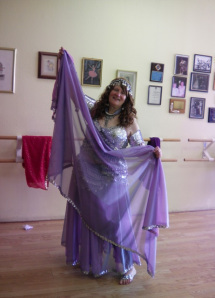 Meantime, I am on another pilgrimage. Bruce Chatwin in Anatomy of Restlessness wrote, “To dance is to go on pilgrimage.” Some people see dancing just as exercise, but for me it’s a way of connecting with life, of being alive, of searching for something intangible, if only proficiency and grace. Dance is a journey of the spirit just as I would hope an epic walk would be, and it’s changing me in some ephemeral way. For example, for the first time in my life, I have no body image problems. All that time in front of a mirror is making me comfortable with the way I look, both my good points and bad. Dancing also seems to reach inside to hidden places and pull out previously unknown joys.
Meantime, I am on another pilgrimage. Bruce Chatwin in Anatomy of Restlessness wrote, “To dance is to go on pilgrimage.” Some people see dancing just as exercise, but for me it’s a way of connecting with life, of being alive, of searching for something intangible, if only proficiency and grace. Dance is a journey of the spirit just as I would hope an epic walk would be, and it’s changing me in some ephemeral way. For example, for the first time in my life, I have no body image problems. All that time in front of a mirror is making me comfortable with the way I look, both my good points and bad. Dancing also seems to reach inside to hidden places and pull out previously unknown joys.
Dancing is the one thing besides physical inability that would change my mind about walking up the coast. It’s a rare and special privilege to be able to learn how to dance at any age but especially when one is sliding down the banister of life.
At the beginning of my journey into grief, a wise woman told me that I could be entering the happiest time of my life, and though it took longer than I expected, I can see that she was right. The pain of grief seems like a portal I went through, and now on the other side I can feel the possibility of true happiness and joy.
Walking. Dancing. Embracing whatever the future might bring.
My pilgrimage.
***
Pat Bertram is the author of the suspense novels Light Bringer, More Deaths Than One, A Spark of Heavenly Fire, and Daughter Am I. Bertram is also the author of Grief: The Great Yearning, “an exquisite book, wrenching to read, and at the same time full of profound truths.” Connect with Pat on Google+. Like Pat on Facebook.
Tagged: Bruce Chatwin, dancing, epic walk, pilgrimage, to dance is to go on pilgrimage, walking up the coast


June 3, 2014
Is the Handwriting on the Wall for Cursive?
Some schools no longer teach handwriting beyond kindergarten or first grade and some teach it not at all. It seems strange to think that few children growing up now will ever write anything by hand, but they won’t need to. Computers, tablets, phones are all just an itch away. Kids today are in constant contact with their peers, using a form of language — textspeak — that would have been anathema just a generation or two ago, but it is their world, not ours. They will have to be living in their “modern” world when we who are adults now are long gone. (I put quotation marks around modern because people in every age going back thousands of years have considered themselves as living in the modern world. And of course, they were right. To people in each era, their contemporary world is like the head of a comet with past trailing along behind. Someday a future era will be at the head — the new “modern” world — and our current modernity will be lost in its tail.)
I read once that the only place besides the brain where we have grey matter is in our fingertips, and perhaps that is true. I seem to have a better hand/brain connection when I am writing longhand than when I am typing on the computer — or at least I did. I wrote my novels long hand because that is the easiest way for me to delve into into myself for the story. I’m not one of those writers who can sit down and let the words flow. I have to sit and think about everything I want to say, and to figure out the best words to show what I decide to say. I’m getting used to writing on a computer since that’s how I write blogs, but I have a hunch that longhand is still the way to get deeper into my mind, where buried insights might have a chance of showing up on paper. And research bears this out. Apparently, writing by hand helps generate ideas.
In school, I always did well on tests without much studying because I took copious notes during class while other students daydreamed, talked, or doodled. New research explains why that was so — supposedly we have a better chance of retaining what we learn if we write it longhand rather than printing it or using a keyboard.
Other research shows that writing longhand, printing, and keyboarding all produce different brain patterns. For optimum brain usage, then, it would seem necessary to use all forms of writing. And yet, learning is not necessarily about optimum brain usage; it’s about standardizing not just information, but the students themselves. (That’s why they’re called standardized tests. If school was about teaching children to be independent or to develop their unique skills, they would be called something else like “Unique skills tests.”
When I started writing this bloggery, I intended to show that cursive was still important, but considering that kids today will have a different world to deal with than we do, maybe it’s better that they learn computer skills early on. But what do I know? Perhaps if I had written this essay by hand instead of typing it, deeper insights would have shown on the page, and I’d have a better grasp of what I think.
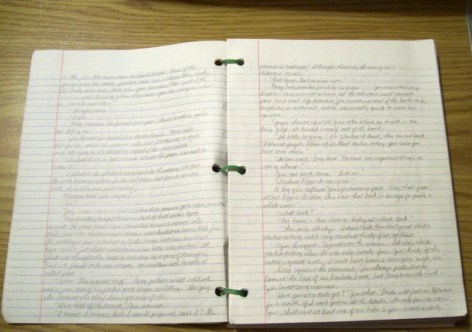
Handwritten copy of A Spark of Heavenly Fire
***
Pat Bertram is the author of the suspense novels Light Bringer, More Deaths Than One, A Spark of Heavenly Fire, and Daughter Am I. Bertram is also the author of Grief: The Great Yearning, “an exquisite book, wrenching to read, and at the same time full of profound truths.” Connect with Pat on Google+. Like Pat on Facebook.
Tagged: cursive, handwriting, modern, modern world, writing by hand, writing longhand


June 2, 2014
Easy Does It, and Other Notable Blog Posts From Second Wind Publishing
The Second Wind Publishing blog always seems to have interesting posts. For example, Harry Margulies, author of The Knowledge Holder, wrote Easy Does It, a wonderful blog about character names that really hit home. One of the many reasons I can’t read fantasy is the fantastic names the authors come up with. Harry’s plea for simple names is humorous and fits my philosophy. My characters are named Bob and Mary and Kate and Phillip. Nice simple names for not so simple characters.
Jay Duret, author of the soon-to-be published novel Nine Digits, wrote Nom de Plume, a funny look at how his pseudonym evolved as his he evolved. For me, it was the other way. I chose as a nom de plume a variation of my name that I wasn’t using at the time simply because it sounded authorly, and somehow I have evolved into that name. Now it’s the one I use both online and in the real world.
Harry Margulies’s most recent post is The Enchanted Food Network, a humorous look at cooking, food networks, and the fantasy of never having to use a Brillo pad.
A year ago, Coco Ihle, author of She Had to Know, wrote Belly Dancing…Dangerous?, which planted the seeds of dancing in my head. I didn’t actually start taking lessons until six months later when I happened upon a nearby studio, but if it weren’t for those seeds, I might not have gone inside and talked to the studio owner. And it changed my life.
Other articles to check out on the Second Wind Publishing blog: A Love Letter to My Magnolia, by Carole Howard, If You Got Transcended Would You Know It? by Lazarus Barnhill, and What is Your Character’s Favorite Color? — by Pat Bertram
***
Pat Bertram is the author of the suspense novels Light Bringer, More Deaths Than One, A Spark of Heavenly Fire, and Daughter Am I. Bertram is also the author of Grief: The Great Yearning, “an exquisite book, wrenching to read, and at the same time full of profound truths.” Connect with Pat on Google+. Like Pat on Facebook.
Tagged: belly dancing, Coco Ihle, Food Network, Harry Margulies, Jay Duret, Second Wind Publishing blog







